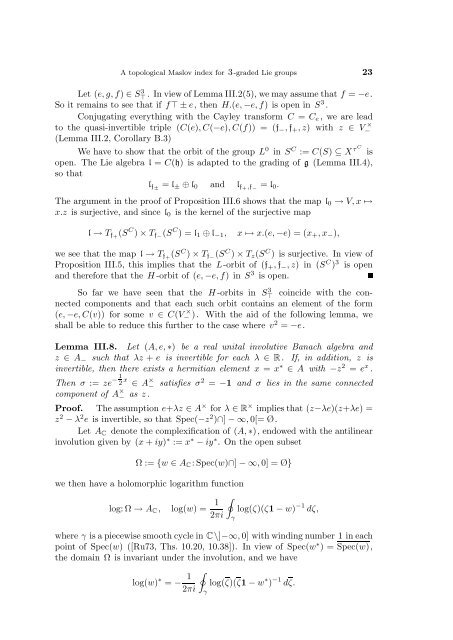A topological Maslov index for 3-graded Lie groups - ResearchGate
A topological Maslov index for 3-graded Lie groups - ResearchGate
A topological Maslov index for 3-graded Lie groups - ResearchGate
Create successful ePaper yourself
Turn your PDF publications into a flip-book with our unique Google optimized e-Paper software.
A <strong>topological</strong> <strong>Maslov</strong> <strong>index</strong> <strong>for</strong> 3-<strong>graded</strong> <strong>Lie</strong> <strong>groups</strong> 23<br />
Let (e, g, f) ∈ S3 ⊤ . In view of Lemma III.2(5), we may assume that f = −e.<br />
So it remains to see that if f⊤ ± e, then H.(e, −e, f) is open in S3 .<br />
Conjugating everything with the Cayley trans<strong>for</strong>m C = Ce, we are lead<br />
to the quasi-invertible triple (C(e), C(−e), C(f)) = (f−, f+, z) with z ∈ V × −<br />
(Lemma III.2, Corollary B.3)<br />
We have to show that the orbit of the group L0 in SC := C(S) ⊆ XτC is<br />
open. The <strong>Lie</strong> algebra l = C(h) is adapted to the grading of g (Lemma III.4),<br />
so that<br />
= l0.<br />
lf± = l± ⊕ l0 and lf+,f−<br />
The argument in the proof of Proposition III.6 shows that the map l0 → V, x ↦→<br />
x.z is surjective, and since l0 is the kernel of the surjective map<br />
l → Tf+ (SC ) × Tf− (SC ) = l1 ⊕ l−1, x ↦→ x.(e, −e) = (x+, x−),<br />
we see that the map l → Tf+ (SC ) × Tf− (SC ) × Tz(S C ) is surjective. In view of<br />
Proposition III.5, this implies that the L-orbit of (f+, f−, z) in (S C ) 3 is open<br />
and there<strong>for</strong>e that the H -orbit of (e, −e, f) in S 3 is open.<br />
So far we have seen that the H -orbits in S3 ⊤ coincide with the connected<br />
components and that each such orbit contains an element of the <strong>for</strong>m<br />
(e, −e, C(v)) <strong>for</strong> some v ∈ C(V × − ). With the aid of the following lemma, we<br />
shall be able to reduce this further to the case where v2 = −e.<br />
Lemma III.8. Let (A, e, ∗) be a real unital involutive Banach algebra and<br />
z ∈ A− such that λz + e is invertible <strong>for</strong> each λ ∈ R. If, in addition, z is<br />
invertible, then there exists a hermitian element x = x ∗ ∈ A with −z 2 = e x .<br />
Then σ := ze −1<br />
2 x ∈ A × − satisfies σ2 = −1 and σ lies in the same connected<br />
component of A × − as z.<br />
Proof. The assumption e+λz ∈ A × <strong>for</strong> λ ∈ R × implies that (z−λe)(z+λe) =<br />
z2 − λ2e is invertible, so that Spec(−z2 )∩] − ∞, 0[= Ø.<br />
Let AC denote the complexification of (A, ∗), endowed with the antilinear<br />
involution given by (x + iy) ∗ := x∗ − iy∗ . On the open subset<br />
Ω := {w ∈ AC: Spec(w)∩] − ∞, 0] = Ø}<br />
we then have a holomorphic logarithm function<br />
log: Ω → AC, log(w) = 1<br />
<br />
2πi<br />
log(ζ)(ζ1 − w) −1 dζ,<br />
where γ is a piecewise smooth cycle in C\]−∞, 0] with winding number 1 in each<br />
point of Spec(w) ([Ru73, Ths. 10.20, 10.38]). In view of Spec(w∗ ) = Spec(w),<br />
the domain Ω is invariant under the involution, and we have<br />
log(w) ∗ = − 1<br />
2πi<br />
<br />
γ<br />
log(ζ)(ζ1 − w<br />
γ<br />
∗ ) −1 dζ.

















